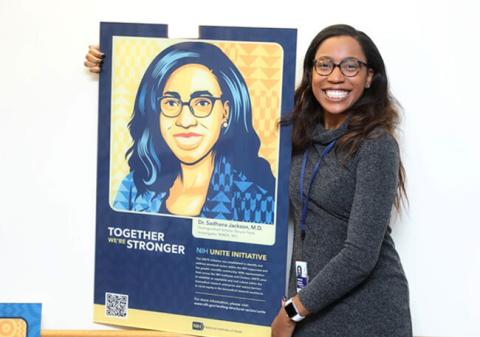
The NIH’s Power of an Inclusive Workplace Recognition Project lead, Sadhana Jackson, MD, holding her portrait before installation in Building 10, south entrance corridor.
On November 19, the National Institutes of Health (NIH) unveiled new portraits of agency staff on its Bethesda, Maryland campus to better reflect and recognize the diversity of everyone who contributes to its mission.
Organizations communicate their identity and culture through the portraits and other artwork they choose to exhibit in their physical and digital spaces. Research on portraits displayed in medical institutions indicate that visible artwork send messages to employees and external audiences about belonging and can communicate unconscious biases related to race/ethnicity and gender. Specifically, viewers of these works interpret the images as a reflection of an institution’s core values and ideal leadership.
NIH’s The Power of an Inclusive Workplace Recognition Project, led by the NIH UNITE initiative, highlights the diversity of the NIH community and recognizes the contributions of employees from different life experiences. Fourteen initial portraits were created by the NIH Medical Arts Branch and unveiled in a recent walkthrough event. The new rotating portraits are on display in Buildings 1 (James Shannon Building), 10 (Clinical Center), and 31 (Claude D. Pepper Building), with exhibits in other buildings and satellite campuses to follow. The portraits feature a range of NIH staff in administrative, scientific, and executive careers at the agency. An online exhibition also enables viewers to access and download the portraits for use in their office settings. Artwork features current NIH staff and future displays will feature former NIH staff, NIH funded researchers, and community collaborators who have contributed to the NIH mission.
The NIH is one of many organizations, including medical schools and academic medical institutions, reflecting on the implicit messages it conveys with historical portraiture and, in turn, updating the visual representations it exhibits in its public spaces and across digital platforms. The NIH’s goal in launching The Power of an Inclusive Workplace Recognition Project is to create a more inclusive workplace culture where all staff, including those from underrepresented groups in the biomedical research enterprise, feel welcome while also demonstrating the agency’s commitment to scientific workforce diversity.
As with the entire biomedical research enterprise, the NIH has historically been male-dominated and majority-white. The result is that contributions to biomedical research and the NIH’s mission by women and other underrepresented groups have largely gone unrecognized for most of the agency’s history—a reality reflected in its visual culture.
While this project updates some of the NIH’s visual representations of its employees, the initiative does not dismiss the history and contributions of former NIH scientists, researchers, or leadership. Instead, it aims to provide a more comprehensive narrative of success and recognition at the NIH by acknowledging everyone who helps advance the agency’s work. The NIH encourages portrait viewers to recognize the contributions of members of underrepresented groups to the agency, reflecting on the varied biomedical career pathways of these employees and considering how underrepresented groups drive science and innovation within the United States.
The Power of an Inclusive Workplace Recognition Project is part of the NIH’s commitment to meaningful culture change, which will occur, in part, when every employee, fellow, contractor, volunteer, and other member of the NIH community is represented in the images that the NIH uses to depict its work. The project is just one of the many actions the NIH is taking to enable greater transparency, accountability, inclusivity, belonging, and communications within the agency and the biomedical research community.

